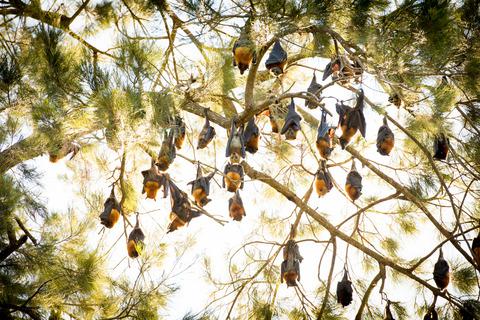当前位置:
X-MOL 学术
›
Remote Sens. Ecol. Conserv.
›
论文详情
Our official English website, www.x-mol.net, welcomes your
feedback! (Note: you will need to create a separate account there.)
Drone-based thermal remote sensing provides an effective new tool for monitoring the abundance of roosting fruit bats
Remote Sensing in Ecology and Conservation ( IF 3.9 ) Pub Date : 2021-04-09 , DOI: 10.1002/rse2.202 Eliane D. McCarthy 1 , John M. Martin 2 , Matthias M. Boer 1 , Justin A. Welbergen 1
Remote Sensing in Ecology and Conservation ( IF 3.9 ) Pub Date : 2021-04-09 , DOI: 10.1002/rse2.202 Eliane D. McCarthy 1 , John M. Martin 2 , Matthias M. Boer 1 , Justin A. Welbergen 1
Affiliation

|
Accurate and precise monitoring of species abundance is essential for determining population trends and responses to environmental change. However, traditional population survey methods can be unreliable and labour-intensive, which complicates the effective conservation and management of many threatened species. We developed a method of using drone-acquired thermal orthomosaics to monitor the abundance of grey-headed flying-foxes (Pteropus poliocephalus) within tree roosts, an IUCN Red Listed species of bat. We assessed the accuracy and precision of this new method and evaluated the performance of four semi-automated methods for counting flying-foxes in thermal orthomosaics, including machine learning and Computer Vision (CV) methods. We found a high concordance between the number of flying-foxes manually counted in drone-acquired thermal imagery and the true abundance of flying-foxes in single roost trees, as obtained from direct on-ground observation. This indicated that the number of flying-foxes observed in thermal imagery accurately reflected the true abundance of flying-foxes. In addition, for thermal orthomosaics of whole roost sites, the number of flying-foxes manually counted was highly repeatable between the same-day drone surveys and human counters, indicating that this method produced highly precise abundance estimates independent of the identity/experience of human counters. Finally, the number of flying-foxes manually counted in drone-acquired thermal orthomosaics was highly concordant with the counts derived from CV and machine learning-enabled classification techniques. This indicated that accurate and precise measures of colony abundance can be obtained semi-automatically, thus greatly reducing the amount of human effort involved for obtaining abundance estimates. Our method is thus valuable for reliably monitoring the abundance of individuals in flying-fox roosts and will aid in the conservation and management of this globally threatened group of flying-mammals, as well as other homeothermic arboreal-roosting species.
中文翻译:

基于无人机的热遥感为监测栖息果蝠的数量提供了一种有效的新工具
准确和精确地监测物种丰度对于确定种群趋势和对环境变化的反应至关重要。然而,传统的人口调查方法可能不可靠且劳动密集型,这使许多受威胁物种的有效保护和管理变得复杂。我们开发了一种使用无人机获得的热正射镶嵌技术来监测灰头狐蝠(Pteropus poliocephalus) 在树栖中,一种被 IUCN 列入红色名录的蝙蝠。我们评估了这种新方法的准确性和精确度,并评估了四种用于计算热正射镶嵌中飞狐的半自动方法的性能,包括机器学习和计算机视觉 (CV) 方法。我们发现在无人机获取的热图像中手动计算的狐蝠数量与从直接地面观察中获得的单个栖息树中狐蝠的真实数量之间存在高度一致性。这表明在热成像中观察到的狐蝠数量准确地反映了狐蝠的真实数量。此外,对于整个栖息地的热正射镶嵌,人工计数的飞狐数量在当天无人机调查和人工计数器之间具有高度可重复性,表明该方法产生了独立于人类计数器的身份/经验的高度精确的丰度估计。最后,在无人机获得的热正射镶嵌中手动计数的飞狐数量与从 CV 和支持机器学习的分类技术得出的计数高度一致。这表明可以半自动地获得准确和精确的菌落丰度测量值,从而大大减少了获得丰度估计值所涉及的人力。因此,我们的方法对于可靠地监测狐蝠栖息地个体的丰度非常有价值,并将有助于保护和管理这一全球受威胁的飞行哺乳动物群,以及其他恒温树栖物种。
更新日期:2021-04-09
中文翻译:

基于无人机的热遥感为监测栖息果蝠的数量提供了一种有效的新工具
准确和精确地监测物种丰度对于确定种群趋势和对环境变化的反应至关重要。然而,传统的人口调查方法可能不可靠且劳动密集型,这使许多受威胁物种的有效保护和管理变得复杂。我们开发了一种使用无人机获得的热正射镶嵌技术来监测灰头狐蝠(Pteropus poliocephalus) 在树栖中,一种被 IUCN 列入红色名录的蝙蝠。我们评估了这种新方法的准确性和精确度,并评估了四种用于计算热正射镶嵌中飞狐的半自动方法的性能,包括机器学习和计算机视觉 (CV) 方法。我们发现在无人机获取的热图像中手动计算的狐蝠数量与从直接地面观察中获得的单个栖息树中狐蝠的真实数量之间存在高度一致性。这表明在热成像中观察到的狐蝠数量准确地反映了狐蝠的真实数量。此外,对于整个栖息地的热正射镶嵌,人工计数的飞狐数量在当天无人机调查和人工计数器之间具有高度可重复性,表明该方法产生了独立于人类计数器的身份/经验的高度精确的丰度估计。最后,在无人机获得的热正射镶嵌中手动计数的飞狐数量与从 CV 和支持机器学习的分类技术得出的计数高度一致。这表明可以半自动地获得准确和精确的菌落丰度测量值,从而大大减少了获得丰度估计值所涉及的人力。因此,我们的方法对于可靠地监测狐蝠栖息地个体的丰度非常有价值,并将有助于保护和管理这一全球受威胁的飞行哺乳动物群,以及其他恒温树栖物种。











































 京公网安备 11010802027423号
京公网安备 11010802027423号